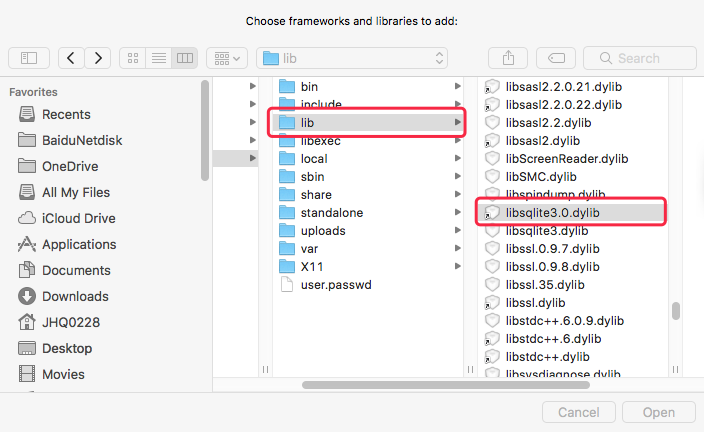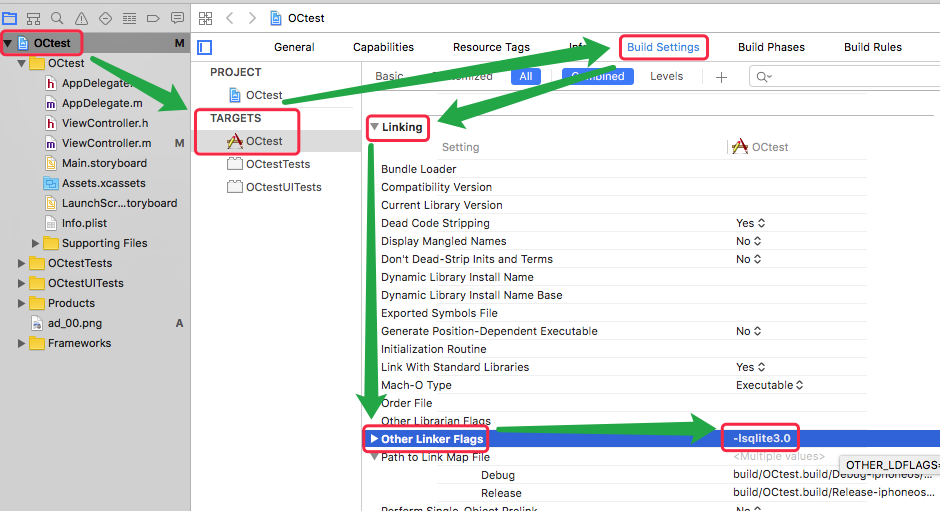前言
- 采用 SQLite 数据库来存储数据。SQLite 作为一中小型数据库,应用 iOS 中,跟前三种保存方式相比,相对比较复杂一些。
- 注意:写入数据库,字符串可以采用 char 方式,而从数据库中取出 char 类型,当 char 类型有表示中文字符时,会出现乱码。
- 这是因为数据库默认使用 ASCII 编码方式。所以要想正确从数据库中取出中文,需要用 NSString 来接收从数据库取出的字符串。
- sqlite 的方法:
sqlite3 *db 数据库句柄,跟文件句柄很类似
sqlite3_stmt *stmt 这个相当于 ODBC 的 Command 对象,用于保存编译好的 SQL 语句
sqlite3_open() 打开数据库,没有数据库时创建。
sqlite3_exec() 执行非查询的 sql 语句
Sqlite3_step() 在调用 sqlite3_prepare 后,使用这个函数在记录集中移动。
Sqlite3_close() 关闭数据库文件
- 还有一系列的函数,用于从记录集字段中获取数据,如:
sqlite3_column_text() 取 text 类型的数据。
sqlite3_column_blob() 取 blob 类型的数据
sqlite3_column_int() 取 int 类型的数据
1、环境配置
2、打开数据库
``` Objective-C
// 打开数据库,数据库文件不存在时,自动创建文件
if (sqlite3_open([databaseFilePath UTF8String], &db) == SQLITE_OK) {
NSLog(@"sqlite dadabase is opened.");
} else {
NSLog(@"sqlite dadabase open fail.");
}
```
3、创建数据表
``` Objective-C
/*
sql 语句,专门用来操作数据库的语句。
create table if not exists 是固定的,如果表不存在就创建。
myTable() 表示一个表,myTable 是表名,小括号里是字段信息。
字段之间用逗号隔开,每一个字段的第一个单词是字段名,第二个单词是数据类型,primary key 代表主键,autoincrement 是自增。
*/
NSString *createSql = @"create table if not exists myTable(id integer primary key autoincrement, name text, age integer, address text)";
if (sqlite3_exec(db, [createSql UTF8String], NULL, NULL, &error) == SQLITE_OK) {
NSLog(@"create table is ok.");
} else {
NSLog(@"error: %s", error);
// 每次使用完毕清空 error 字符串,提供给下一次使用
sqlite3_free(error);
}
```
4、插入记录
NSString *insertSql = @"insert into myTable(name, age, address) values('小新', '8', '东城区')";
if (sqlite3_exec(db, [insertSql UTF8String], NULL, NULL, &error) == SQLITE_OK) {
NSLog(@"insert operation is ok.");
} else {
NSLog(@"error: %s", error);
// 每次使用完毕清空 error 字符串,提供给下一次使用
sqlite3_free(error);
}
5、修改记录
NSString *updateSql = @"update myTable set name = '小白', age = '10', address = '西城区' where id = 2";
if (sqlite3_exec(db, [updateSql UTF8String], NULL, NULL, &error) == SQLITE_OK) {
NSLog(@"update operation is ok.");
} else {
NSLog(@"error: %s", error);
// 每次使用完毕清空 error 字符串,提供给下一次使用
sqlite3_free(error);
}
6、删除记录
NSString *deleteSql = @"delete from myTable where id = 3";
if (sqlite3_exec(db, [deleteSql UTF8String], NULL, NULL, &error) == SQLITE_OK) {
NSLog(@"delete operation is ok.");
} else {
NSLog(@"error: %s", error);
// 每次使用完毕清空 error 字符串,提供给下一次使用
sqlite3_free(error);
}
7、查询记录
sqlite3_stmt *statement;
// @"select * from myTable" 查询所有 key 值内容
NSString *selectSql = @"select id, name, age, address from myTable";
if (sqlite3_prepare_v2(db, [selectSql UTF8String], -1, &statement, nil) == SQLITE_OK) {
while(sqlite3_step(statement) == SQLITE_ROW) {
// 查询 id 的值
int _id = sqlite3_column_int(statement, 0);
// 查询 name 的值
NSString *name = [NSString stringWithUTF8String:(char *)sqlite3_column_text(statement, 1)];
// 查询 age
int age = sqlite3_column_int(statement, 2);
// 查询 name 的值
NSString *address = [NSString stringWithUTF8String:(char *)sqlite3_column_text(statement, 3)];
NSLog(@"id: %i, name: %@, age: %i, address: %@", _id, name, age, address);
}
} else {
NSLog(@"select operation is fail.");
}
sqlite3_finalize(statement);
8、关闭数据库
sqlite3_close(db);


